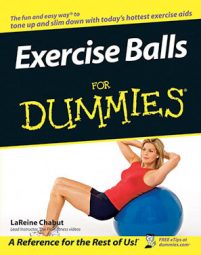The principles of using the exercise ball come into play as soon as you combine the instability of the ball (caused by its round shape) with the smooth, hard surface of the floor, which is stable. This factor makes the exercise ball an excellent tool for doing challenging exercises that require great strength and control. Before you begin your workout, read up on the following principles to gain a better understanding of why the ball is so challenging in the first place.
Proper exercise ball positioning
You can use quite a few positions with the ball, and they’re all dictated by which ball exercises you choose to do. Like with any other piece of equipment, positioning along with proper form is very important. Following is a list of the most-common ball positions, along with an example of an exercise that you can do with each position:
Sitting on the ball: Abdominal curls (being sure to keep your lower back on the ball as you bend your knees at a 90-degree angle and you rest your feet on the floor).
Lying backward on the ball: Backbend stretch (being sure to sit on the ball first and then slowly walk your legs forward until your back is lying backward over the ball).
Lying sideways on the ball: Lateral curls or side stretch (being sure to first kneel on the floor and position your right hip and side against the ball).
Lying forward on the ball or on your tummy: The drape, or draping your body over the ball (being sure to place your feet on the floor behind you and your hands on the floor in front of you).
Lying on the floor with your legs on the ball: Hamstring lifts or roll away (being sure to press your lower legs into the ball and rest your arms by your sides on the floor).
Range of motion with an exercise ball
Because the ball moves freely, it creates a wider range of motion for working your joints and keeping them flexible as opposed to working with a weight bench. When you train on the ball, you use a full range of motion and recruit additional muscle groups to maintain proper form.
The ball’s full range of motion serves as a kind of check and balance system because, if you don’t do each exercise correctly, you fall on your butt! Keeping the ball steady lets you know immediately whether or not you’re maintaining good posture and proper form.
Coordination and balance with an exercise ball
When you take away the stability of a chair and sit on the ball, you change your center of gravity and alter the way you need to sit; that is, you sit up straight (otherwise known as having good posture).
Working on coordination and balance at the same time recruits the brain and the muscles, so you get more bang for your buck while working out on the ball. Using your stabilizing muscles (deeper abdominal muscles) to maintain your balance and concentrating so you don’t fall off the ball may be the two most important principles of working with the ball.

